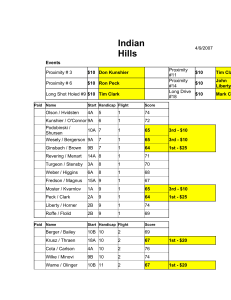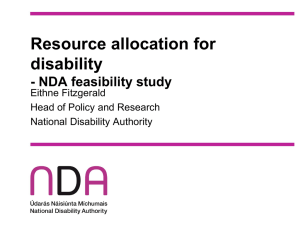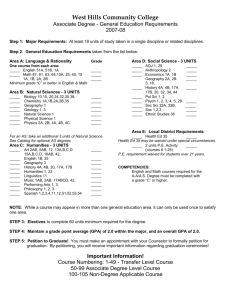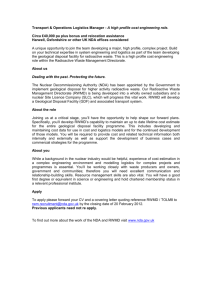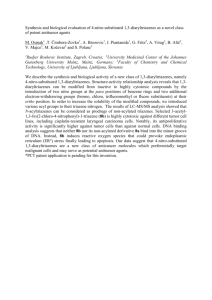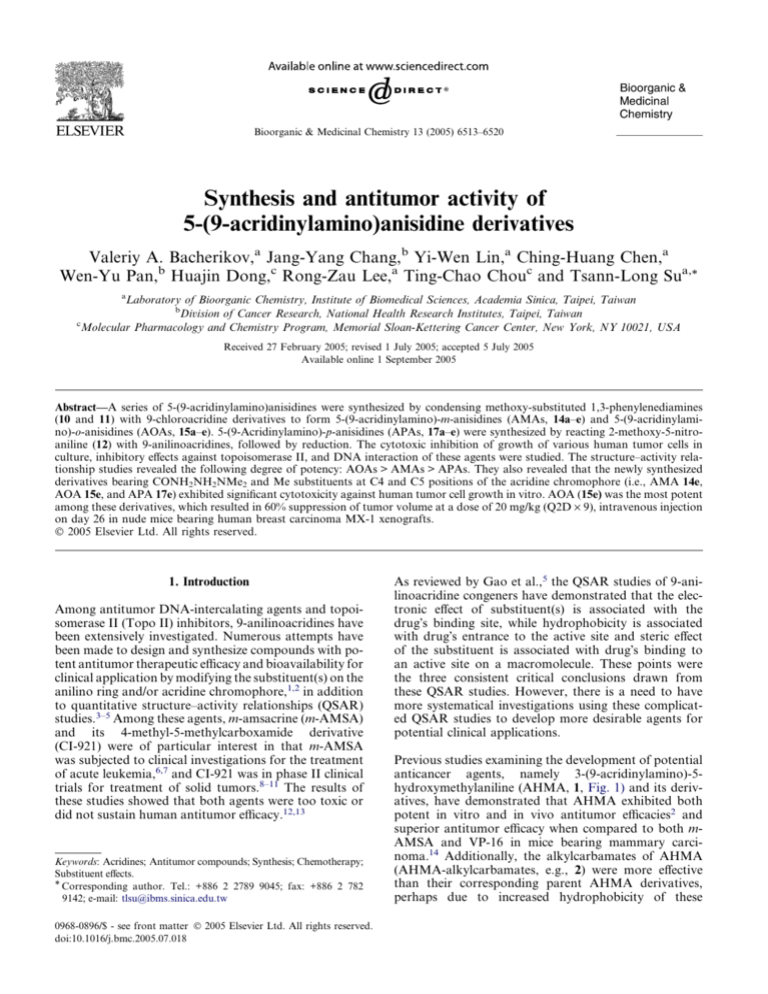
Bioorganic & Medicinal Chemistry 13 (2005) 6513–6520
Synthesis and antitumor activity of
5-(9-acridinylamino)anisidine derivatives
Valeriy A. Bacherikov,a Jang-Yang Chang,b Yi-Wen Lin,a Ching-Huang Chen,a
Wen-Yu Pan,b Huajin Dong,c Rong-Zau Lee,a Ting-Chao Chouc and Tsann-Long Sua,*
a
Laboratory of Bioorganic Chemistry, Institute of Biomedical Sciences, Academia Sinica, Taipei, Taiwan
b
Division of Cancer Research, National Health Research Institutes, Taipei, Taiwan
c
Molecular Pharmacology and Chemistry Program, Memorial Sloan-Kettering Cancer Center, New York, NY 10021, USA
Received 27 February 2005; revised 1 July 2005; accepted 5 July 2005
Available online 1 September 2005
Abstract—A series of 5-(9-acridinylamino)anisidines were synthesized by condensing methoxy-substituted 1,3-phenylenediamines
(10 and 11) with 9-chloroacridine derivatives to form 5-(9-acridinylamino)-m-anisidines (AMAs, 14a–e) and 5-(9-acridinylamino)-o-anisidines (AOAs, 15a–e). 5-(9-Acridinylamino)-p-anisidines (APAs, 17a–e) were synthesized by reacting 2-methoxy-5-nitroaniline (12) with 9-anilinoacridines, followed by reduction. The cytotoxic inhibition of growth of various human tumor cells in
culture, inhibitory effects against topoisomerase II, and DNA interaction of these agents were studied. The structure–activity relationship studies revealed the following degree of potency: AOAs > AMAs > APAs. They also revealed that the newly synthesized
derivatives bearing CONH2NH2NMe2 and Me substituents at C4 and C5 positions of the acridine chromophore (i.e., AMA 14e,
AOA 15e, and APA 17e) exhibited significant cytotoxicity against human tumor cell growth in vitro. AOA (15e) was the most potent
among these derivatives, which resulted in 60% suppression of tumor volume at a dose of 20 mg/kg (Q2D · 9), intravenous injection
on day 26 in nude mice bearing human breast carcinoma MX-1 xenografts.
2005 Elsevier Ltd. All rights reserved.
1. Introduction
Among antitumor DNA-intercalating agents and topoisomerase II (Topo II) inhibitors, 9-anilinoacridines have
been extensively investigated. Numerous attempts have
been made to design and synthesize compounds with potent antitumor therapeutic efficacy and bioavailability for
clinical application by modifying the substituent(s) on the
anilino ring and/or acridine chromophore,1,2 in addition
to quantitative structure–activity relationships (QSAR)
studies.3–5 Among these agents, m-amsacrine (m-AMSA)
and its 4-methyl-5-methylcarboxamide derivative
(CI-921) were of particular interest in that m-AMSA
was subjected to clinical investigations for the treatment
of acute leukemia,6,7 and CI-921 was in phase II clinical
trials for treatment of solid tumors.8–11 The results of
these studies showed that both agents were too toxic or
did not sustain human antitumor efficacy.12,13
Keywords: Acridines; Antitumor compounds; Synthesis; Chemotherapy;
Substituent effects.
* Corresponding author. Tel.: +886 2 2789 9045; fax: +886 2 782
9142; e-mail: tlsu@ibms.sinica.edu.tw
0968-0896/$ - see front matter 2005 Elsevier Ltd. All rights reserved.
doi:10.1016/j.bmc.2005.07.018
As reviewed by Gao et al.,5 the QSAR studies of 9-anilinoacridine congeners have demonstrated that the electronic effect of substituent(s) is associated with the
drugs binding site, while hydrophobicity is associated
with drugs entrance to the active site and steric effect
of the substituent is associated with drugs binding to
an active site on a macromolecule. These points were
the three consistent critical conclusions drawn from
these QSAR studies. However, there is a need to have
more systematical investigations using these complicated QSAR studies to develop more desirable agents for
potential clinical applications.
Previous studies examining the development of potential
anticancer agents, namely 3-(9-acridinylamino)-5hydroxymethylaniline (AHMA, 1, Fig. 1) and its derivatives, have demonstrated that AHMA exhibited both
potent in vitro and in vivo antitumor efficacies2 and
superior antitumor efficacy when compared to both mAMSA and VP-16 in mice bearing mammary carcinoma.14 Additionally, the alkylcarbamates of AHMA
(AHMA-alkylcarbamates, e.g., 2) were more effective
than their corresponding parent AHMA derivatives,
perhaps due to increased hydrophobicity of these
6514
V. A. Bacherikov et al. / Bioorg. Med. Chem. 13 (2005) 6513–6520
NHR
NH2
CH2OH
HN
HN
N
R2
Me
N
R1
2
1
R
R
1 R = R1 = R2 = H (AHMA)
2 R = COOEt, R1 = R2 = H
1
2
3 R = H, R = CONHCH2CH2NMe2, R = Me,
1
2
4 R = R = H (AMT)
1
2
5 R = CONHCH2CH2NMe2, R = Me,
NH2
Me
Me
HN
HN
NH2
N
N
2
1
R
1
R
2
6 R = R = H (APT)
7 R1 = CONHCH2CH2NMe2, R2 = Me,
2
R
1
R
8 R1 = R2 = H (AOT)
1
2
9 R = CONHCH2CH2NMe2, R = Me,
Figure 1.
agents.15 The structure–activity relationship studies of
AHMA derivatives have demonstrated that the CH2OH
functional group on the anilino ring played an important role in their antitumor activity, probably via
involvement in drug/DNA binding. More recently, we
found that conversion of the CH2OH group to an ester
increases its hydrophobicity and the cytotoxicity of 2
was enhanced further. Replacing the CH2OH substituent with a Me group at the meta-, para- or ortho-position to the NH2 group, 5-(9-acridinylamino)-mtoluidines (AMTs, 4 and 5), 5-(9-acridinylamino)-p-toluidines (APTs, 6 and 7), or 5-(9-acridinylamino)-o-toluidines (AOTs, 8 and 9) were formed, respectively, which
were more hydrophobic than the parent AHMA.16 The
results showed that compounds 4, 6, and 8 were less
cytotoxic than AHMA, indicating that either removal
of the CH2OH or replacement of this functional group
with Me reduced its cytotoxicity further and weakened
its inhibitory effect against Topo II. However, 5-(9acridinylamino)toluidine analogs (5, 7, and 9) bearing
CONHCH2CH2NMe2 and Me functions at C4 and C5
of the acridine chromophore, respectively, were more
potent than AHMA (1) and AHMA-ethylcarbamate
(2) or as potent as AHMA derivative 3 depending on
the tumor cell line tested. These three agents exhibited
potent therapeutic effects in mice bearing human breast
carcinoma MX-1 xenografts. Moreover, APTs and
AOTs were more potent than AMTs, perhaps due to
the inductive effect of the Me function.
The studies indicated that the electronegativity of the
anilino ring induced by the Me group may affect the
drug/enzyme interaction and consequently the drugs
cytotoxicity. For example, the substituents (CONHCH2CH2NMe2 and Me functions) on the acridine
chromophore may have influenced the drug/DNA interaction and hence altered the cytotoxicity of the 9-anilinoacridines. Earlier reports have demonstrated that adding
an electron-donor OMe group on the anilino ring of 9anilinoacridine increased its antitumor potency.17 Based
on these findings, one can envisage that the cytotoxicity
of 5-(9-acridinylamino)toluidines can be enhanced
further by replacing the Me function with the elevated
electron-donating OMe group to increase the electronegativity of the anilino ring. In this paper, we described the
synthesis and biological evaluations of a series of 5-(9acridinylamino)-m-anisidines (AMAs), 5-(9-acridinylamino)-p-anisidines (APAs), and 5-(9-acridinylamino)-oanisidines (AOAs). The structure–activity relationship
studies concluded that the target AOAs and AMAs were
more cytotoxic than the corresponding AOTs and AMTs
in inhibiting growth of various human tumor cells in vitro, with the exception of APAs.
2. Chemistry
5-(9-Acridinylamino)-m-anisidines (AMAs, 14a–e) were
synthesized by the condensation of 3,5-diaminoanisole
dihydrochloride (10) with the known 9-chloroacridines
(13a–e) in CHCl3/EtOH in the presence of 4-methylmorpholine in an ice/MeOH bath by following a procedure previously developed in our laboratory.14,16
Under such conditions, good yield of 14a–e was
obtained as hydrochloride salts. In a similar manner,
the reaction of 2,4-diaminoanisole dihydrochloride (11)
V. A. Bacherikov et al. / Bioorg. Med. Chem. 13 (2005) 6513–6520
with the requisite 9-chloroacridines (13a–e) afforded 5(9-acridinylamino)-o-anisidines (AOAs, 15a–e) in good
yield. It is interesting to note that the reaction of 11 with
13a–e may afford the isomers AOAs (15a–e) and/or 5-(9acridinylamino)-p-anisidines (APAs, 17a–e). To identify
the structure of 15a–e, we first treated 2-methoxy-5-nitroaniline (12) with 9-chloroacridines (13a–e) in a mixture of CHCl3/EtOH in the presence of a catalytic
amount of concd hydrochloric acid. The product, acridin-9-yl-(2-methoxy-5-nitrophenyl)amines (16a–e), was
then converted to APAs (17a–e) upon catalytic hydrogenation (5% Pd/C, H2) (see Scheme 1).
6515
to the Me groups in APTs and AOTs, however, show
no apparent difference.
3. Biological results and discussion
3.1. In vitro cytotoxicity
Our previous study has demonstrated that 5-(9-acridinylamino)toluidine derivatives bearing CONHCH2CH2NMe2 and Me substituents at C4 and C5 of the
acridine moiety, respectively, exhibited remarkable cytotoxicity both in vitro and in vivo, while, the simple 5-(9acridinylamino)toluidines were less cytotoxic than the
parent AHMA.16 The results demonstrated that the
electronegativity on the anilino ring, the substituent(s)
on the acridine chromophore, as well as the hydrophobicity of the molecule, greatly influenced the cytotoxicity
of 9-anilinoacridines. In the present studies, we evaluated the cytotoxic effects of target (9-acridinylamino)anisidines (AMAs, 14a–e; AOAs, 15a–e; and APAs, 17a–e)
against numerous human tumor cell (including mouth
KB, nasopharyngeal carcinoma HONE-1, lung adenocarcinoma H460, colon HT-29, gastric carcinoma
TSGH, hepatoma Hepa-G2, brain tumor DBTRG,
and breast carcinoma MX-1) growth in culture (Table
1). The data clearly revealed that AOA 15e was the most
potent compound among the 5-(9-acridinylamino)anisidines bearing CONCH2CH2NMe2 and Me substituents
(AMA 14e, AOA 15e, and APA 17e) at C4 and C5,
respectively. The order of cytotoxicity was as follows:
The structures of AOAs (15a–e) and APAs (17a–e) were
determined by the 1H NMR spectroscopy method. The
1
H NMR (DMSO-d6) spectra of the series of AOAs
(15a–e) and APAs (17a–e) revealed that chemical shifts
for their OMe substituent can be clearly distinguished;
the signal for protons of the OMe functional group in
AOAs (15a–e) locates appears at a lower field than that
of APAs (17a–e) with d 3.84–3.91 and 3.36–3.45,
respectively. While the chemical shifts of OMe groups
in AMAs (15a–e) are about d 3.64–3.67. Apparently,
the NH2 function at C4 of 2,4-diaminoanisole (11) is
more reactive than the one at C2, resulting in the formation of AOAs (15a–e) as the prominent products. In
contrast, our previous study showed that the reaction
of 2,4-diaminotoluene with 9-chloroacridines (13a)
afforded APTs (i.e., 6). In this case, the C2-NH2 is more
reactive than the C4-NH2 due to a weaker inductive
effect of the Me function. The chemical shifts assigned
NH2
NH2
H2N
HN
OMe
OMe
N
10
2
(i)
NH2
1
R
R
OMe
14a-e
Cl
NH2
HN
OMe
(i)
+
H2N
N
11
R2
N
R1
13a-e
2
R
(i)
1
15a-e
R
NH2
MeO
MeO
OMe
HN
O 2N
HN
NO2
NH2
(ii)
12
N
N
2
1
R
R
16a-e
2
R
1
17a-e
R
Scheme 1. Reagents and reaction conditions: (i) 4-methylmorpholine (or catalytic concd HCl)/EtOh/CHCl3, 10–0C, 1–5; (ii) 5% Pd/C, H2,
Catalytic concd HCl, 50 psi, 25 min. (a) R1 = R2 = H; (b) R1 = Me, R2 = H; (c) R1 = CONHCH2CH2NMe2, R2 = H; (d) R1 = CONHMe, R2 = Me;
(e) R1 = CONHCH2CH2NMe2, R2 = Me.
6516
V. A. Bacherikov et al. / Bioorg. Med. Chem. 13 (2005) 6513–6520
Table 1. The cytotoxicity of 5-(9-acridinylamino)anisidine derivatives on the inhibition of growth various human tumor cells in vitro
Compound
Inhibition of cell growth (IC50, lM)
KB
1 (AHMA)
3
AMT4
14a
14b
14c
14d
14e
AMT5
AOT8
15a
15b
15c
15d
15e
AOT9
APT6
17a
17b
17c
17d
17e
APT7
a
HONE-1
a
ND
NDa
NDa
3.20
2.83
0.70
2.71
0.09
NDa
NDa
0.32
0.32
0.31
0.39
0.03
NDa
NDa
6.45
6.36
0.88
2.55
0.13
NDa
0.30
0.04
3.40
3.32
2.90
0.73
3.11
0.06
0.09
0.90
0.33
0.34
0.15
0.50
0.03
0.09
0.80
6.50
4.82
2.12
3.07
0.10
0.07
H460
a
ND
NDa
NDa
2.57
1.45
0.44
2.06
0.03
NDa
NDa
0.33
0.29
0.08
0.19
0.01
NDa
NDa
3.31
2.40
0.36
0.43
0.02
NDa
HT-29
TSGH
HEPA-G2
DBTRG
MCF-7
0.90
0.12
3.50
3.00
2.78
0.47
2.73
0.05
0.09
2.50
0.34
0.38
0.12
0.60
0.02
0.09
2.50
7.79
8.62
0.88
4.53
0.27
0.05
0.50
0.40
7.20
2.96
2.67
0.38
2.83
0.03
0.12
2.50
0.38
0.38
0.14
0.62
0.03
0.08
4.10
8.28
7.73
0.91
3.32
0.10
0.04
1.40
0.20
3.20
3.56
3.24
0.41
3.91
0.04
0.06
4.0
0.35
0.36
0.15
0.97
0.02
0.10
2.50
5.93
10.75
2.06
8.00
0.29
0.10
3.50
0.16
10.0
4.70
5.00
1.69
14.77
0.18
2.8
4.30
2.93
2.45
1.32
2.33
0.08
0.30
4.00
5.77
21.67
1.59
14.88
2.23
0.86
NDa
NDa
NDa
4.89
4.15
1.16
6.67
0.18
NDa
NDa
2.08
2.60
1.19
3.24
0.01
NDa
NDa
7.92
26.19
3.37
17.50
2.00
NDa
Not determined.
AOA 15e > AMA 14e > APA 17e. Among compounds
with or without other substituent(s) on the acridine
chromophore (i.e., AMA 14a–d, AOAs 15a–d, and
APAs 17a–d), the C4-CONH2NH2NMe2-substituted
derivatives (i.e., AMA 14c, AOA 15c, and APA 17c)
were approximately 2- to 10-fold more potent than their
corresponding parent AMA 14a, AOA 15a, and APA
17a, which depends on the tumor cell lines tested. The
C4-Me-substituted (i.e., AMA 14b, AOA 14b, and
APA 17b) and C4-CONHMe, C5-Me-disubstituted
compounds (i.e., AMA 14d, AOA 15d, and APA 17d)
did not have any improved cytotoxic effect in comparison with their corresponding parent compounds 14a,
15a, and 17a, respectively. This demonstrated that the
CONH2NH2NMe2 substituent played an important role
for their antitumor activity, perhaps due to better binding affinity with DNA double strands.8,16 In general, the
order of potency in the series of 5-(9-acridinylamino)anisidines was as follows: AOAs > AMAs > APAs.
To elicit the effect of the OMe versus Me substituent attached on the anilino ring, we compared the cytotoxicity
of 5-(9-acridinylamino)anisidines with those of previously synthesized AHMAs (1 and 3) and 5-(9-acridinylamino)toluidines (AMTs, 4, 5; AOTs, 6, 7; and APTs, 8,
9). The structure–activity relationship studies of these
agents concluded that: (1) Both AMA 14e and AOA
15e were more cytotoxic than AHMA derivative 3, while
APA 17e was less potent than 3 and (2) The degree of
cytotoxicity was AMAs > AMTs; AOAs > AOTs; APTs
> APAs. Our previous study had demonstrated that
APTs were as potent as AOTs, but were significantly
more cytotoxic than AMTs, with the exception of those
compounds having Me and CONH2NH2NMe2 substituents on the acridine chromophore (i.e., 5, 7, 9, 14e, 15e,
and 17e). These findings have suggested that the Me
group (possessing an inductive effect) and the electron-
donating OMe group affect the electronegativity of the
anilino ring and consequently alter the drug/enzymebinding and antitumor activity. The effect of the substituent on the cytotoxicity of 9-anilinoacridines can be
clearly observed in APT and APA families. The reason
for the low cytotoxicity of APAs (especially, APA
17a–d) remains unclear. Nevertheless, these studies have
demonstrated that the drug/DNA binding of 9-anilinoacridines appears to be one of the most important factors for increasing the 9-anilinoacridines cytotoxicity,
as exhibited by 14e, 15e, and 17es potent antitumor
activity in vitro.
We evaluated further the effect of the newly synthesized
compounds on cells overexpressing P-gp170/MDR118
and MRP (multidrug resistance-associated protein).19
As shown in Table 2, the cytotoxicity of 14a, 14e, 15a,
15e, 17a, and 17e toward KB-Vin10 and KB-7D cells,
which displayed overexpression of MDR1, MRP, and
down-regulation of topoisomerase II, respectively, was
similar to that of parental KB cells, indicating that 5(9-acridinylamino)anisidines were not cross-resistant to
etoposide-resistant (KB-7D) and vincristine-resistant
(KB-Vin10) cells.
3.2. In vivo therapeutic activity
Among the agents tested, compound 15e exhibited the
most potent cytotoxic effect toward numerous human
cancer cell lines and was subjected to further in vivo
antitumor evaluation. The therapeutic efficacy of compound 15e [maximal dose: 20 mg/kg (Q2D · 9); intravenous injection] on nude mice (n = 4) bearing human
breast carcinoma MX-1 xenograft resulted in 60%
reduction of tumor with 20% of body weight decrease
compared with the control (n = 5) on day 26. Cain
V. A. Bacherikov et al. / Bioorg. Med. Chem. 13 (2005) 6513–6520
6517
Table 2. The cytotoxicity of 5-(9-acridinylamino)anisidine derivatives against human tumor KB and its sublines resistant to etoposide (KB-7D) and
vincristine (KB-Vin10) cell growth in vitro
Compound
AHMA
14a
14e
15a
15e
17a
17e
VP-16
Vincristine
a
b
Inhibition of cell growth (IC50, lM)
KB
KB-7D
KB-Vin10
PLDB (%) at 5 lM
0.50
2.45
0.08
0.31
0.02
6.0
0.12
0.40
0.0012
1.50 (3.0·)a
3.06 (1.25·)
0.21 (2.65·)
0.25 (0.80·)
0.03 (1.50·)
7.1 (0.18·)
0.29 (2.42·)
78.8 (197·)
5.6 (4667·)
0.70 (1.4·)a
2.75 (1.12·)
0.25 (3.13·)
0.23 (0.74·)
0.04 (2.00·)
7.0 (1.16·)
0.32 (2.67·)
31.5 (78.8·)
75.8 (65417·)
12.0
0.0
1.2
6.5
0.6
4.6
4.3
NDb
NDb
Numbers in the brackets are folds of resistance of the resistant cells when compared with the IC50s of the KB parent cells.
Not determined.
et al. indicated that increasing the electronic effect of
substituents on the anilino ring of 9-anilinoacridines increased vulnerability for thiol attack,20,21 thereby
decreasing its cytotoxicity. This effect may be due to
instability of the anisidine moiety in AOAs and APAs.
These agents could be easily bio-oxidized to form relatively inactive compounds (i.e., ortho- or para-iminoquinone derivative, respectively).
3.3. Interaction of AHMA, APT, and AMT derivatives
with topoisomerase II
In our previous study, AHMA and its analogs were shown
to be potent Topo II inhibitors.14,15 To study whether
these compounds also inhibited Topo II catalytic activity,
an ATP-dependent Topo II-mediated DNA relaxation
assay was performed. The results for the representative
compounds are shown in Figure 2, where AHMA, AMTs,
and APTs bound tightly to the DNA at concentrations of
5–25 lM. Since Topo II inhibitors are capable of inducing
double-stranded breaks, an in vitro K-SDS co-precipitation assay for measuring the amount of protein-linked
DNA breaks (PLDBs) induced by AHMA, 14a, 14e,
15a, 15e, 17a, and 17e, was performed. After a 30 min
exposure to an increased concentration of these compounds, except for compound 15b, steady-state levels of
PLDBs were increased in a dose-dependent manner, followed by a plateau at a concentration of 5 lM (data not
shown). It reveals that there is a slight difference in PLDB
level in the AMA compounds (0.0 and 1.2% for 14a and
14e, respectively) and no difference among APA compounds (4.6 and 4.3% for 17a and 17e, respectively). However, the amount of PLDBs generated by 15a was
significantly higher than 15e. Thus, a direct correlation
between the PLDB values of compounds tested and their
cytotoxicity was not seen. A similar result was found in
the series of (9-acridinylamino)toluidine derivatives.16
3.4. Interaction of AHMA, APT, and AMT derivatives
with DNA
To study the correlation between cytotoxicity and the
DNA-binding affinity of AHMA, APTs, and AMTs, a
DNA circle-ligation assay with linearized DNA and
T4 ligase was performed. The assay detected tertiary
structure changes resulting from DNA binding to both
Figure 2. Inhibition of the DNA topoisomerase II catalytic activity by
5-(9-acridinylamino)anisidine derivatives. The experiment was performed by the method described previously.26
intercalating and non-intercalating compounds. The result showed that AHMA caused a dose-dependent band
shift and produced a positive supercoiled DNA at concentrations greater than 2.5 lM (Fig. 3), indicating a
change in the drug/DNA-linking number. Additionally,
the DNA remained unchanged in the presence of 14e,
15e, or 17e at 10 lM, suggesting that there was strong
DNA intercalation and T4 ligase inhibition in the presence of these agents. The DNA-binding affinities for 14e,
15e, or 17e are greater than those for 14a, 15a, and 17a,
respectively, and were more cytotoxic than the other
tested compounds. The present results together with previous findings have demonstrated that increase in drug/
DNA-binding activity enhanced the cytotoxicity of 9anilinoacridines.
4. Conclusion
We have synthesized a series of 5-(9-acridinylamino)anisidine derivatives for antitumor studies against a
6518
V. A. Bacherikov et al. / Bioorg. Med. Chem. 13 (2005) 6513–6520
Figure 3. Effect of DNA unwinding by 5-(9-acridinylamino)anisidine derivatives measure, as described previously.28,29
variety of human tumor cell growth in vitro. AOT 15e
appeared to be the most potent agent among the compounds tested in this series. The SAR studies showed
that compounds bearing CONCH2CH2NMe2 and Me
substituents (AMA 14e, AOA 15e, and APA 17e) at
C4 and C5 of the acridine chromophore, respectively,
displayed potent cytotoxic effect in inhibiting growth
of various human tumor cells in culture. Additionally,
the present studies have demonstrated that the most
important factor that affects the cytotoxicity of 5-(9acridinylamino)anisidine (or 9-anilinoacridines) is the
drug/DNA-binding affinity. However, electronegativity
generated by the substituent (Me or OMe) on the anilino
ring and hydrophobicity of the drug may have some
effect on the drugs biological activity. The current
systematic SAR studies will be beneficial for designing
future 9-anilinoacridines with increased potent antitumor therapeutic efficacy.
5. Experimental
5.1. Materials and methods
Melting points were determined on a Fargo melting
point apparatus and are uncorrected. Column chromatography was carried out on silica gel G60 (70–230
mesh, ASTM, Merck and 230–400 mesh, Silicycle
Inc.). Thin-layer chromatography was performed on silica gel G60 F254 (Merck) with short-wavelength UV
light for visualization. Elemental analyses were done
on a Heraeus CHN-O Rapid instrument. 1H NMR spectra were recorded in DMSO-d6 solution on a 600 MHz
Brucker AVANCE 600 DRX spectrometer, and chemical shifts are reported in ppm, relatively to TMS. Splitting patterns are designated as follows: s, singlet; br s,
broad singlet; d, doublet; t, triplet; q, quartet; m,
multiplet.
5.2. General procedure for the preparation of
5-(9-acridinylamino)anisidines
All new 5-(9-acridinylamino)anisidines (14a–e, 15a–e,
and 16a–e) were prepared by the condensation of the
requisite substituted 9-chloroacridines (13a–e) and the
appropriate MeO-substituted 1,3-phenylenediamines
(10 and 11) or 2-methoxy-5-nitroaniline (12) in a mixture of CHCl3 and EtOH in the presence of 4-methylmorpholine (for 14a–e and 15a–e) or concd HCl (for
16a–e) by following the method described previously.14,16 The desired products were purified either by
recrystallization or chromatography on a silica gel column. Compounds 17a–e were synthesized by the reaction of 16a–e under catalytic hydrogenation (5% Pd/C,
H2) in EtOH solution in the presence of concd HCl.
The synthesis of representative compounds is given below. The analytic data and yield of other new derivatives
are shown in Table 3.
5.2.1.
N-Acridin-9-yl-5-methoxybenzene-1,3-diamine
(AMA 14a). A suspension of 3,5-diaminoanisole dihydrochloride (2.11 g, 10 mmol) and 4-methylmorpholine
(4.8 mL, 43.6 mmol) in ethanol (30 mL) was stirred in
an ice-methanol bath for 10 min. A solution of 9-chloroacridine (13a, 3.44 g, 16 mmol) in CHCl3 (50 mL) was
then added dropwise to the above mixture and stirred
at 5 C for 2 h and then at room temperature overnight. The resulting solid product was collected by filtration and then recrystallized from EtOH to give 14a,
2.24 g (71%); mp 235–236 C; 1H NMR d 3.84 (3H, s,
OMe); 5.58 (2H, br s, NH2), 6.17 (1H; s, ArH), 6.23
(2H, br s, 2· ArH); 7.45 (2H, m, 2· ArH), 7.97 (2H,
m, 2· ArH); 8.11 (2H, m, 2· ArH), 8.35 (2H, m, 2·
ArH). Anal. (C20H17N3OÆHClÆ0.2H2O) C, H, N.
By following the same procedure as that for the synthesis of 14a, compounds 14b–e and 15a–e were prepared.
5.2.2.
N-Acridin-9-yl-4-methoxybenzene-1,3-diamine
(APA 17a). A mixture of 16a (1.15 g, 3.0 mmol) and 5%
Pd/C in methanol (250 mL) containing concd HCl
(0.5 mL) was hydrogenated at 50 psi for 25 min. The mixture was filtered through a pad of Celite and the solid cake
was washed with methanol. The filtrate and washing were
combined and evaporated under reduced pressure to dryness. The residue was chromatographed on a silica gel
column (2 · 24 cm) using CHCl3/MeOH (10:1 v/v) as
the eluent. The product 17a was eluted from CHCl3/
MeOH (5:1 v/v). Fractions containing 17a were combined and concentrated under reduced pressure. The res-
V. A. Bacherikov et al. / Bioorg. Med. Chem. 13 (2005) 6513–6520
6519
Table 3. Analytic data and yield of 5-(9-acridinylamino)anisidines
*
Compound
Chemical formula*
mp (C)
Yield (%)
Analysis
14a
14b
14c
14d
14e
15a
15b
15c
15d
15e
16a
16b
16c
16d
16e
17a
17b
17c
17d
17e
C20H17N3OÆHClÆ0.2H2O
C21H19N3OÆ2HClÆH2O
C25H27N5O2Æ4HClÆ0.5H2O
C23H22N4O2Æ0.25HClÆ0.25H2O
C26H29N5O3Æ4HClÆ2.5H2O
C20H17N3OÆ2.5HClÆ0.8H2O
C21H19N3OÆ2HClÆ0.5H2O
C25H27N5O2Æ5HClÆ3.2H2O
C23H22N4O2ÆHClÆ3.7H2O
C26H29N5O2Æ3HClÆ3.6H2O
C20H15N3OÆHClÆ0.1H2O
C20H15N3O3Æ0.8HClÆ1.8H2O
C25H25N5O4ÆHClÆ2H2O
C23H22N4O2Æ1.53HClÆ0.25H2O
C26H27N5O4Æ2HClÆ2H2O
C20H17N3OÆHClÆ0.6H2O
C21H19N3OÆ5HClÆ0.5H2O
C25H27N5O2Æ2.5HClÆ4.1H2O
C23H22N4O2Æ2.5HCl.0.8H2O
C26H29N5O2Æ4HClÆ3.5H2O
235–236
224–225
257–258
224–225
207–208
283–284
280–283
221–222
220–221
173–174
239–240
207–208
185–186
254–255
208–209
243–244
230–231
207–208
278–279
229–230
71
69
55
77
45
91.4
86
58.6
53
75
90
74
72
74
73
70
84
51
83
72
C,
C,
C,
C,
C,
C,
C,
C,
C,
C,
C,
C,
C,
C,
C,
C,
C,
C,
C,
C,
H,
H,
H,
H,
H,
H,
H,
H,
H,
H,
H,
H,
H,
H,
H,
H,
H,
H,
H,
H,
N
N
N
N
N
N
N
N
N
N
N
N
N
N
N
N
N
N
N
N
All compounds are hygroscopic and contain HCl and crystal water.
idue was treated with 4.2 N HCl/EtOAc (3 mL) and then
evaporated in vacuo to dryness. The residue was co-evaporated several times with EtOH and the solid residue was
recrystallized from EtOH/acetone to give 17a, 667 mg
(70%); mp 243–245 C; 1H NMR d 3.36 (3H, s, OMe),
6.73 (1H, m, ArH), 6.78 (1H, m, ArH), 6.96 (1H, m,
ArH), 7.39 (2H, m, ArH), 7.94 (2H, m, ArH), 8.05 (2H,
m, 2· ArH), 8.27 (2H, m, 2· ArH), 10.36 (2H, br s,
exchangeable, NH2), 11.49 (1H, br s, exchangeable,
NH). Anal. (C20H17N3OÆHClÆ0.6H2O) C, H, N.
By following the same procedure as that for the synthesis of 17a, compounds 17b–e were prepared.
5.3. Biological assays
5.3.1. Cytotoxicity assays. The effects of the compounds
on cell growth were determined in all human tumor cells
(i.e., colon HT-29, nasopharyngeal carcinoma HONE-1
and BM-1, hepatoma Hepa-G2, breast carcinoma MX1, gastric carcinoma TSGH, brain tumor DBTRG, oral
carcinoma KB, breast carcinoma MCF-7 and MX-1,
and T-cell acute lymphocytic leukemia CCRF-CEM),
for a 72 h incubation, by the XTT-tetrazolium assay,
as described by Scudiero et al.22 After the addition of
phenazine methosulfate-XTT solution at 37 C for 6 h,
absorbance at 450 and 630 nm was detected on a microplate reader (EL 340; Bio-Tek Instruments Inc., Winooski, VT). Six to seven concentrations of each compound
were used. The IC50 and dose–effect relationships of the
compounds for antitumor activity were calculated by a
median-effect plot,23,24 using a computer program on
an IBM PC workstation.25
5.3.2. Inhibition of topoisomerase II catalytic activity by
drugs. Topo-II catalytic activity was assayed by the
ATP-dependent relaxation of pBR322 supercoiled
DNA.26 Various concentrations of the drugs were incubated with 2 U DNA topoisomerase II (Topogen) and
0.25 lg pBR322 DNA. The inhibition of relaxation
activity was determined by comparison with an untreated control. AHMA was used as a positive control.
5.3.3. Measurement of protein-linked DNA breaks. Cells
in log-phase growth were labeled with [14C]thymidine
for 24 h. After labeling, the cells were trypsinized, resuspended in fresh medium at a density of 5 · 105 cells/mL,
and shaken gently in a 37 C water bath for 1 h in suspension. Various concentrations of drugs were added
and incubation was continued for an additional 0.5 h.
The cells were collected and analyzed for protein-linked
DNA breaks by potassium-sodium dodecyl sulfate (KSDS) precipitation method, as described previously.27
The percentage of PLDBs generated by the compounds
was calculated by radioactivity (cpm) of precipitated
DNA divided by the total radioactivity (cpm).
5.3.4. DNA unwinding measurement. The DNA unwinding effect of drugs was assayed according to the method
described by Camilloni et al.28 Briefly, 20 lg of pBR322
DNA was linearized with HindIII restriction endonuclease and recovered by phenol/chloroform extraction and
ethanol precipitation. The reaction mixtures (totally
200 lL) containing 66 mM Tris–HCl (pH 7.6), 6 mM
MgCl2, 10 mM dithiothreitol, 0.7 mM ATP, 0.6 lg
DNA, and drugs were equilibrated at 15 C for 10 min
and then incubated with excess amount of T4 DNA ligase at 15 C for 60 min. The reaction was stopped by
the addition of 20 mM EDTA. DNA was analyzed by
agarose-gel electrophoresis after treatment to remove
the drugs from the reaction mixture: extraction with phenol and ether, and precipitation with ethanol. DNA was
resuspended in 25 lL TE buffer with 1% SDS and analyzed in 1% agarose gel in TAE overnight.29
5.3.5. In vivo assay. Athymic nude mice bearing the
nu/nu gene were used for human breast tumor MX-1
xenograft. Outbred Swiss-background mice were ob-
6520
V. A. Bacherikov et al. / Bioorg. Med. Chem. 13 (2005) 6513–6520
tained from Chares River Breeding Laboratories. Male
mice 7 weeks old or older weighing 22 g or more were
used for experiments. Drug was administered via tail
vein by iv injection. Tumor volumes were assessed by
measuring the length · width · height (or width) by
using caliper. Vehicle used was 20 lL DMSO, diluted
with 180 lL saline. All animal studies were conducted
in accordance with the Guidelines of the National Institutes of Health Guide for the Care and Use of Animals
and the protocol approved by the Institutional Animal
Care and Use Committee.
Acknowledgments
This work was supported by the National Science Council of Taiwan (Grant No. NSC92-2320-B-001-004). The
NMR spectra of synthesized compounds were obtained
at High-Field Biomacromolecular NMR Core Facility
supported by the National Research Program for Genomic Medicine (Taiwan).
Supplementary data
The 1H NMR spectroscopic data of compounds listed in
Table 3 can be found, in the online version, at
doi:10.1016/j.bmc.2005.07.018.
References and notes
1. Denny, W. A. In The Chemistry of Antitumor Agents;
Wilman, D. E. V., Ed.; Blackie, Chapman and Hall: New
York, 1990, pp 1–29.
2. Su, T.-L. Curr. Med. Chem. 2002, 9, 1677.
3. Denny, W. A.; Cain, B. F. J. Med. Chem. 1978, 21, 430.
4. Baguley, B. C.; Denny, W. A.; Atwell, G. J.; Cain, B. F.
J. Med. Chem. 1981, 24, 170.
5. Gao, H.; Denny, W. A.; Garg, R.; Hansch, C. Chem. Biol.
Interact. 1998, 116, 157.
6. Legha, S. S.; Gutterman, J. U.; Hall, S. W.; Benjamin, R.
S.; Burgess, M. A.; Valdivieso, M.; Bodey, G. P. Cancer
Res. 1978, 38, 3712.
7. Cabanillas, F.; Legha, S. S.; Bodey, G. P.; Freireich, E. J.
Blood 1981, 57, 614.
8. Baguley, B. C.; Denny, W. A.; Atwell, G. J.; Finlay, G. J.;
Rewcastle, G. W.; Twigden, S. J.; Wilson, W. R. Cancer
Res. 1984, 44, 3245.
9. Wilson, W. R.; Denny, W. A.; Twigden, S. J.; Baguley, B.
C.; Probert, J. C. Br. J. Cancer 1984, 49, 215.
10. Sklarin, N. T.; Wienrnik, P. H.; Grove, W. R.; Benson, L.;
Mittelman, A.; Maroun, J. A.; Stewart, J. A.; Robert, F.;
Doroshow, J. H.; Rosen, P. J. Invest. New Drug 1992, 10,
309.
11. Harvey, V. J.; Hardy, J. R.; Smith, S.; Grove, W.;
Baguley, B. C. Eur. J. Cancer 1991, 27, 1617.
12. De Jager, R.; Siegenthaler, P.; Cavalli, F.; Klepp, O.;
Bramwell, V.; Joss, R.; Albert, P.; Van Glabbeke, M.;
Renard, J.; Rozencweig, M.; Hansen, H. H. Eur. J. Cancer
Clin. Oncol. 1985, 19, 289.
13. Issell, B. F. Cancer Treat. Rev. 1980, 7, 73.
14. Su, T.-L.; Chou, T.-C.; Kim, J. Y.; Huang, J.-T.;
Ciszewska, G.; Ren, W.-Y.; Otter, G. M.; Sirotnak, F.
M.; Watanabe, K. A. J. Med. Chem. 1995, 38, 3226.
15. Su, T.-L.; Chen, C.-H.; Huang, L.-F.; Chen, C.-H.; Basu,
M. K.; Zhang, X.-G.; Chou, T.-C. J. Med. Chem. 1999,
42, 4741.
16. Chang, J.-Y.; Lin, C.-F.; Pan, W.-Y.; Bacherikov, V. A.;
Chou, T.-C.; Chen, C.-H.; Dong, H.; Cheng, S.-Y.; Tsai,
T.-J.; Lin, Y.-W.; Chen, K.-T.; Chen, L.-T.; Su, T.-L.
Bioorg. Med. Chem. 2003, 11, 4959.
17. Cain, B. F.; Atwell, G. J.; Denny, W. A. J. Med. Chem.
1975, 18, 1110.
18. Kuo, C. C.; Hsieh, H. P.; Pan, W. Y.; Chen, C. P.; Liou, J.
P.; Lee, S. J.; Chang, Y. L.; Chen, L. T.; Chen, C. T.;
Chang, J. Y. Cancer Res. 2004, 64, 4621.
19. Ferguson, P. J.; Fisher, M. H.; Stephenson, J.; Li, D. H.;
Zhou, B. S.; Cheng, Y. C. Cancer Res. 1988, 48, 5956.
20. Cain, B. F.; Wilson, W. R.; Baguley, B. C. Mol.
Pharmacol. 1976, 12, 1027–1035.
21. Denny, W. A.; Cain, B. F.; Atwell, G. J.; Hansch, C.;
Panthananickal, A.; Leo, A. J. Med. Chem. 1982, 25,
276.
22. Scudiero, D. A.; Shoemaker, R. H.; Paull, K. D.; Monks,
A.; Tierney, S.; Nofziger, T. H.; Currens, M. J.; Seniff, D.;
Boyd, M. R. Cancer Res. 1988, 48, 4827.
23. Chou, T.-C.; Talalay, P. Adv. Enzyme Regul. 1984, 22, 27.
24. Chou, T.-C. In Synergism and Antagonism in Chemotherapy; Chou, T.-C., Rideout, D. C., Eds.; Academic Press:
New York, NY, 1991, pp 61–102.
25. Chou, J.; Chou, T.-C. Dose–Effect Analysis with
Microcomputers: Quantitation of ED50, LD50, Synergism, Antagonism, Low-Dose Risk, Receptor–Ligands
Binding and Enzyme Kinetics; Biosoft: Cambridge,
UK, 1987.
26. Yamashita, Y.; Kawada, S.; Fujii, N.; Nakano, H.
Biochemistry 1991, 30, 5838.
27. Rowe, T. C.; Chen, G. L.; Hsiang, Y. H.; Liu, L. F.
Cancer Res. 1986, 46, 2021.
28. Camilloni, G.; Della Seta, F.; Negri, R.; Grazia Ficca, A.;
Di Mauro, E. EMBO J. 1986, 5, 763.
29. Montecucco, A.; Pedrali-Noy, G.; Spadari, S.; Zanolin,
E.; Ciarrocchi, G. Nucleic Acid Res. 1988, 16, 3907.

